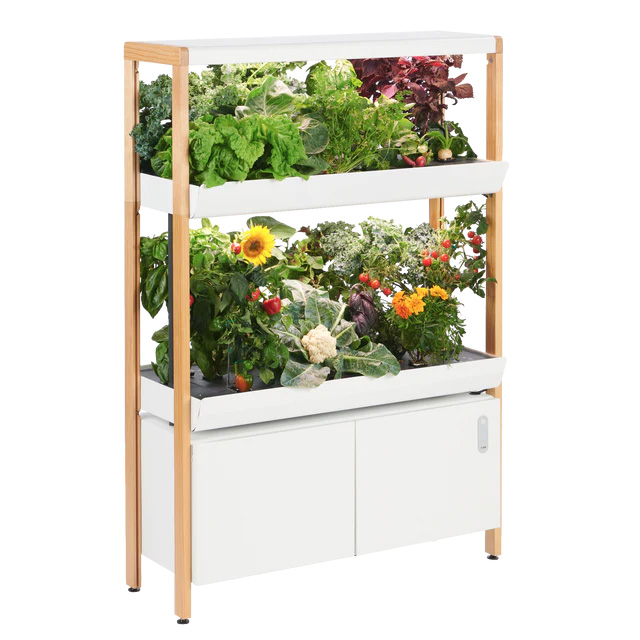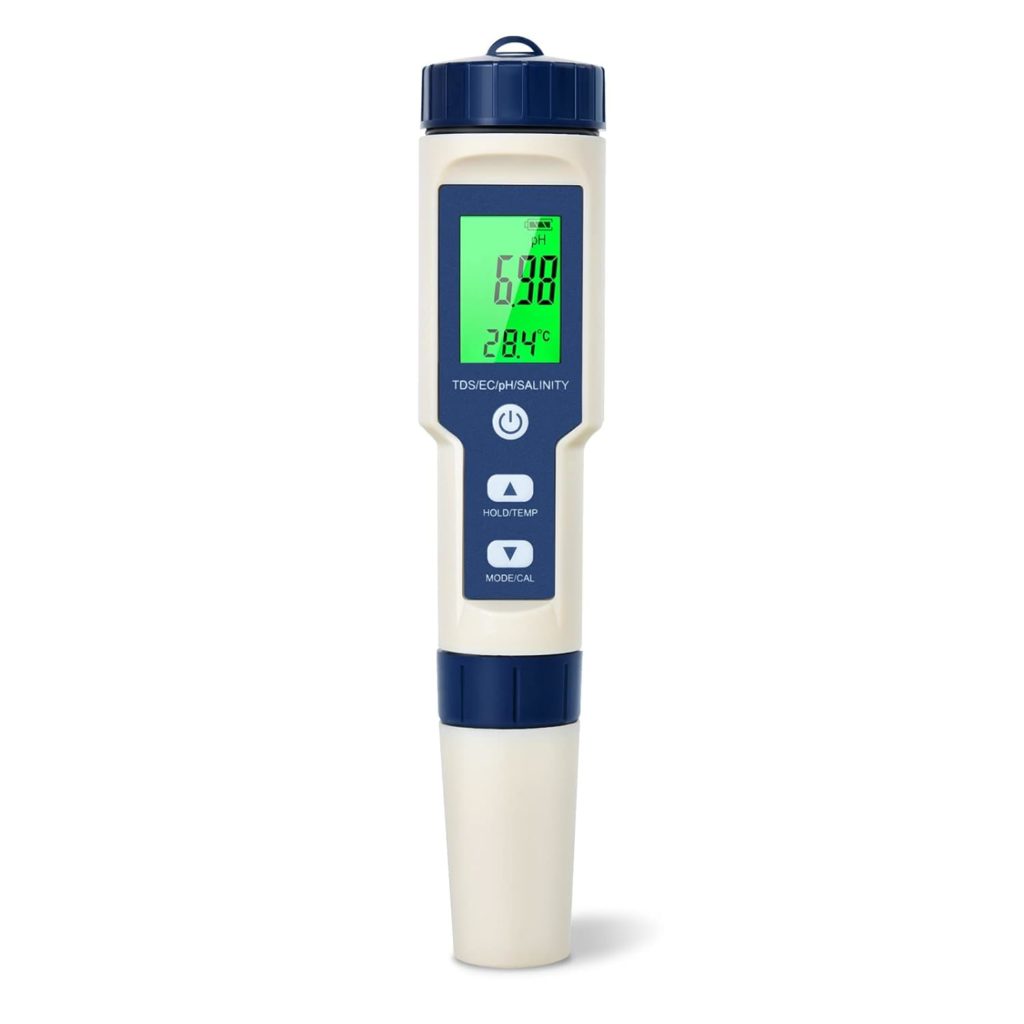Purchasing the Letpot LPH-Max countertop hydroponic growing system, which I discussed in my article titled “Review of the Letpot LPH-MAX Hydroponic Culture System,” sparked my interest in investing a bit more to acquire a hydroponic system with a larger capacity that would allow me to grow larger quantities of vegetables on a larger scale. That’s why, on September 1st, I made the decision to order a two-tiered Rise Gardens family hydroponic system.
I was able to combine two promotional offers (a 10% discount for signing up for the manufacturer’s newsletter along with a 20% end-of-summer discount). So, instead of costing me the hefty sum of $1,399, it only cost me $1,007.10 (sic). To this amount, delivery charges must be added, for a total of $1,064.83.



There is also a smaller version of the Rise Gardens, which retails for $479 at the regular price.
Introduction of the family-sized Rise Gardens hydroponic system
The Rise Gardens hydroponic gardening system was officially launched in January of this year at the 2023 Consumer Electronics Show (CES) in Las Vegas. You can watch the company’s founder discuss it in the video below.
While other indoor garden systems are made of plastic and PVC pipes, the New Rise Garden uses powder-coated metal, a genuine wood structure, and features a refined and minimalist aesthetic designed to blend seamlessly into any room in any size of home. After much consideration, I ultimately chose the charcoal-colored version, and I have no regrets. The wood of the Rise Garden complements my kitchen table and the hardwood floor in my dining room perfectly.
Equipped with Wi-Fi connectivity and a control app available on the Apple Store and Google Play, nothing has been left to chance. Thanks to its intelligent hydroponic growing technology, the new Rise Gardens family unit automatically waters and fertilizes the plants, and the app precisely indicates when to add nutrients and water, manages the lighting, allows you to track plant growth, and even informs you when it’s time to harvest. You can configure the number of hours of lighting and pump operation through it. The system also offers Alexa integration for voice control.
A ‘nursery’ is also included to initiate the seed germination process.

Unlike the previous version, no pH and water EC (electro-conductivity) reader is provided. You simply input the plant varieties placed in the system through an app, and it calculates the amount of nutrients and water they need using an artificial intelligence algorithm that utilizes plant growth data from the app. This method is called ‘Smart Care’ in the app.
“According to Rise Gardens, relying on pH and EC sensors to add nutrients can be tricky, as their accuracy would depend entirely on calibration and would require specific storage environments to remain calibrated. Rise Gardens, therefore, sought a more reliable and consistent solution. They managed to develop a method that only requires knowing the identity of the plants present in the system to provide a way of adding nutrients that doesn’t rely on a sensor that could become uncalibrated or run out of batteries. They also no longer wanted to continue selling replacement sensors and calibration kits, as it went against the user-friendly hydroponic gardening model they were aiming to create. However, this method requires diligence because all plant movements must be logged in the app so that it is aware of the plants present in the system, enabling it to calculate nutrient needs effectively. So, you need to inform the app when adding or harvesting plants.

So, I will naturally opt for the ‘Smart Care’ method to start with to assess its effectiveness, but I may switch to ‘Sensor Care’ mode at some point out of curiosity. I will then need to acquire a reader to determine the water parameters in my system. This device will allow me to determine if the water is nutrient-deficient or, conversely, nutrient-rich by measuring water conductivity, with higher conductivity indicating a higher nutrient concentration (completely pure water has almost no conductivity). So, it’s a crucial value in the field of hydroponic cultivation. You can find a variety of models on Amazon, ranging in cost from about $30 to $90.
In this latest version of their hydroponic garden, Rise Gardens boasts of having created a system that is even easier to clean, easier and faster to assemble than its predecessor, with more durable electronic components, and several features such as a larger water reservoir that enhances the quality and quantity of plants that can be grown. I will naturally be able to share my experience on this in the coming months.
“The New Rise Garden is the only fully modular smart indoor garden on the market. No other system offers such flexibility and productivity,” said Hank Adams, CEO and founder of Rise Gardens. “With this latest version, we have enhanced the features that already set our brand apart – productivity, functionality, and an elegant, minimalist aesthetic.”
Key Features of the Family Rise Gardens
- Available in two colors (white and charcoal)
- Modular System – The expandable garden allows you to add up to 3 levels and expand up to 36 plants per level with optional trays (12 plants per base level).
- Professional – 30W full-spectrum LED lights that mimic natural sunlight to maximize plant growth.
- Automatic Watering – A 9-gallon system that only requires weekly refilling. Automatically dispenses the perfect amount of water to the plants.
- Connected (Wi-Fi) – The app guides you step by step throughout the growth process with reminders, tips, and more.
- Voice Control – Take care of your garden from the couch with the help of Alexa.
- Starter Kit Included – pH adjustment and nutrient liquid bottles are provided to get you started.”
An assortment of 16 seed pods that vary over time is included with the system. In my case, I received pods of iceberg lettuce, Parris Island lettuce, Butter Crunch lettuce, cilantro, basil, parsley, celery, and chives.
While some emphasize the ‘economic’ aspect of growing their own vegetables in such a hydroponic system, I express some skepticism, as the prices of Rise Gardens seed kits are rather high. For instance, it costs about $14 for a set of 4 lettuces ($3.49 per lettuce), to which you must add the cost of nutrients. To get a better idea, I will pay close attention to the price of lettuce this winter because, in the summer, the price is obviously much lower.
According to an article published on the Rise Gardens website, it would be possible to grow $3,000 worth of produce per year in a 3-tier Family Rise Gardens system by selecting high-yield plants that sell for a high price in grocery stores.
Rise Gardens offers over 75 seed varieties in ready-to-grow pods that you can explore HERE.
However, it is possible to only purchase sponges made of peat moss and coconut coir and plant your own seeds in them. However, the app may not recognize them, which could theoretically impact nutrient addition recommendations during their growth. Rise Gardens’ business model is designed to strongly encourage its customers to remain within its ecosystem, which is designed to simplify their lives but obviously comes with a cost.
However, unlike many other hydroponic systems like Letpot or Aerogarden, you need to buy the sponges directly from Rise Gardens as they are not available on Amazon.
Note: Upon further investigation, it appears that some sponge models available on Amazon, like this one, have very similar dimensions to those of Rise Gardens sponges. It will need to be tested as compatibility with the Rise Gardens system is not mentioned, but the price is much lower ($0.34 per sponge versus $0.78 for the original Rise Gardens sponges).
Conclusion
So, I’ll stop here for today, and I’ll be back shortly with a new article that will cover the assembly and my initial impressions of the Rise Gardens family hydroponic system.


Note: If you ever decide to purchase a Rise Gardens hydroponic system, you can do so by following this link, which will allow you to get a $50 discount.





